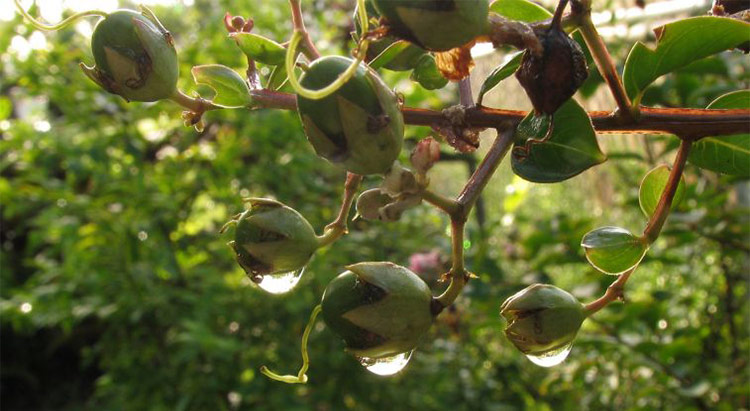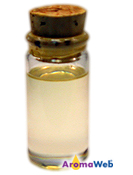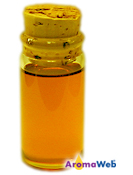Myrtle Essential Oil
Myrtus communis

Description
When working with Myrtle Essential Oil, it is helpful to pay close attention to the botanical name and its chemical composition. Both Green Myrtle Essential Oil and Red Myrtle Essential Oil typically share the same botanical name, Myrtus communis. Generally speaking, both essential oils share similar applications. However, Green Myrtle Essential Oil contains significantly more of the monoterpene a-Pinene than does Red Myrtle, and Red Myrtle contains much more of the oxide 1,8 Cineole than does Green Myrtle.

Green Myrtle Essential Oil is generally sourced from Corsica. Red Myrtle Essential Oil tends to be redder in color than Green Myrtle Essential Oil, but this is not necessarily a foolproof way or determining the composition of the particular Myrtle Essential Oil that you have.

Both Green and Red Myrtle Essential Oils share a light, fresh, uplifting aroma. However, Red Myrtle Essential Oil is more "camphorous" in aroma due to its significantly higher 1,8 Cineole content. 1,8 Cineole is an oxide, but it is somewhat camphor-like in aroma.
Emotionally, Green Myrtle Essential Oil may be helpful in calming the mind, easing anxiety and promoting restful sleep.
Green and Red Myrtle Essential Oils blend particularly well with essential oils in the mint, herbaceous, wood and citrus families.
Myrtle Essential Oil Benefits and Uses
- Respiratory Issues
- Bronchitis
- Coughs
- Colds
- Fatigue
- Exhaustion
- Insomnia
- Acne
- Boils
- Hemorrhoids
- Urinary Tract Infections
Sources: Valerie Ann Worwood, The Complete Book of Essential Oils and Aromatherapy, 25th Anniversary Edition (Novato, CA: New World Library, 2016, 606-607. Salvatore Battaglia, The Complete Guide to Aromatherapy (Australia: The Perfect Potion, 2003), 235-236.
Botanical Name
Plant Family
Common Method of Extraction
Steam Distilled
Plant Part Typically Used
Color
Green Myrtle Essential Oil is typically pale yellow in color. Red Myrtle Essential Oil typically possesses an orange-red hue.
Consistency
Thin
Perfumery Note
Top - Middle
Strength of Initial Aroma
Medium
Aromatic Description
Myrtle Essential Oil is sweet, fresh, green and slightly camphorous in aroma. Red Myrtle Essential Oil smells camphorous than does Green Myrtle Essential Oil due to its higher 1,8 Cineole content.
Sustainability and Conservation Status
Least Concern
Source: https://www.iucnredlist.org/species/203365/119997141
To learn more about the conservation status of essential oil bearing plants and how to use the IUCN Red List of Threatened Species, please refer to AromaWeb's Guide to Essential Oils and Sustainability.
Major Constituents of Green Myrtle Essential Oil
- a-Pinene
- 1,8-Cineole
- Myrtenyl Acetate
- (+)-Limonene
- Linalool
See Essential Oil Safety for more complete list of typical constituents.
Source: B.M. Lawrence, Essential Oils 1988-1991 (Wheaton: Allured Publishing, 1995), 80-82. Source cited in Robert Tisserand and Rodney Young, Essential Oil Safety (Second Edition. United Kingdom: Churchill Livingstone Elsevier, 2014), 358.
Major Constituents of Red Myrtle Essential Oil
- 1,8-Cineole
- a-Pinene
- Myrtenyl acetate
- (+)-Limonene
- a-Terpineol
See Essential Oil Safety for more complete list of typical constituents.
Source: Private Communication: Berger, 1998. Source cited in Robert Tisserand and Rodney Young, Essential Oil Safety (Second Edition. United Kingdom: Churchill Livingstone Elsevier, 2014), 357-358.
Myrtle Essential Oil Safety Information
Tisserand and Young recommend a maximum dermal use level of "1.9% for myrtle oils based on either 1.4% estragole and 0.8% methyleugenol content or 0.2% estragole and 1.0% methyleugenol content, and dermal limits of 0.12% and 0.02% for estragole and emthyleugenol, respectively." Reading Tisserand and Young's full profile is recommended. [Robert Tisserand and Rodney Young, Essential Oil Safety (Second Edition. United Kingdom: Churchill Livingstone Elsevier, 2014), 357-358.]
General Safety Information
Do not take any oils internally and do not apply undiluted essential oils, absolutes, CO2s or other concentrated essences onto the skin without advanced essential oil knowledge or consultation from a qualified aromatherapy practitioner. For general dilution information, read AromaWeb's Guide to Diluting Essential Oils. If you are pregnant, epileptic, have liver damage, have cancer, or have any other medical problem, use oils only under the proper guidance of a qualified aromatherapy practitioner. Use extreme caution when using oils with children and be sure to first read the recommended dilution ratios for children. Consult a qualified aromatherapy practitioner before using oils with children, the elderly, if you have medical issues or are taking medications. Before using this or any essential oil, carefully read AromaWeb's Essential Oil Safety Information page. For in-depth information on oil safety issues, read Essential Oil Safety by Robert Tisserand and Rodney Young.
Shelf Life
Important Information About the Profiles
The essential oil information provided on AromaWeb is intended for basic educational purposes only. The references to safety information, test results, constituents and percentages is generalized information. Essential oils can vary greatly in composition. The data is not necessary complete and is not guaranteed to be accurate. The essential oil photos are intended to represent the typical and approximate color of each essential oil. However, essential oil composition and color can vary based on harvesting, distillation, age of the essential oil and other factors. Profiles for several CO2 Extracts and absolutes are included within the directory, and are denoted as such.
